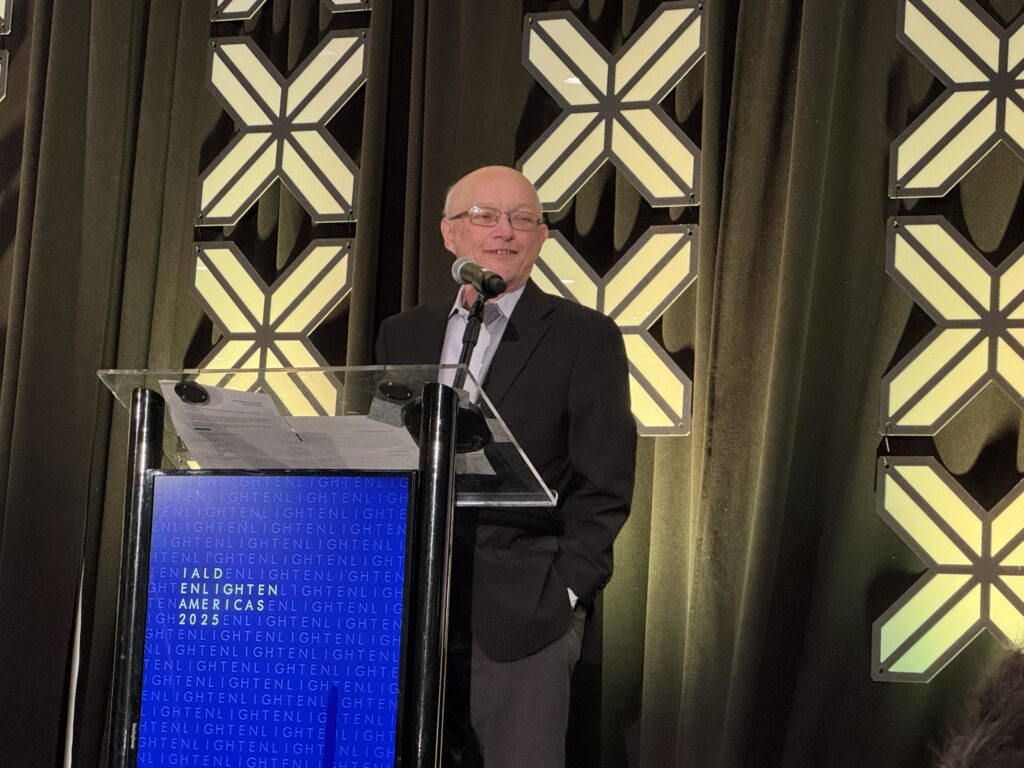Randy Burkett’s Lifetime Achievement Award: A Life in Light
Early Roots: From Rural Pennsylvania to Lighting Design
IALD’s highest honor—the Lifetime Achievement Award—went to Randy Burkett, and his acceptance felt less like a victory lap and more like a conversation with friends. He opened with a wry smile, thanking the IALD for “this most humbling of honors,” then added, “We’ve had a small group receive this award over the years, and I hope it gets a lot bigger. I certainly don’t represent all the folks who should be up here.”
Randy grew up in rural Pennsylvania and eventually found his way to Penn State’s architectural engineering program. “I didn’t know what I wanted to do,” he said, “and then I found lighting. It gave me a lifetime of thinking with both sides of my brain.” He credited the late John Flynn, whose research on how light shapes human behavior left “an indelible mark.”
Study abroad widened his world. Time at the University of Leeds and the Institute of Advanced Architectural Studies fueled his interest in light’s science. Early roles sharpened the technical side. “My first job honed the optics and the math—exactly what Professor Flynn told me I needed,” he said.
St. Louis brought him into HOK’s lighting practice. “Those eight years kept pushing me to do better work,” he said. By 1988 he launched his own studio. He laughed about a Louvre mishap—backing up to view a canvas and stepping on his former boss’s foot—an awkward moment that became a fun story.

Randy Burkett receives the IALD Lifetime Achievement Award at IALD Enlighten Americas 2025 in Tucson
Mentors, Meaning, and a Renaissance
Founding a firm was purpose as much as business. “Since 1988, we’ve been in private practice,” he said. “There’s nothing I’d do differently—other than more projects, perhaps.” He paused, then added, “Lighting is a wonderful place to be in design. We make differences in people’s lives. Even when we don’t celebrate it as much as we should, it changes how people feel and move and gather.”
He thanked those who shaped his path: David L. DiLaura, Mark Rea, and Edison Price—“a legend to me”—as well as Lesley Wheel and Craig Roeder, who used color fearlessly and left too soon. He saluted Dave Munson at HOK and David Mintz, a collaborator on the Martin Luther King, Jr. Memorial bridge. He remembered Jonathan Speirs and offered this advice: “Keep people in your life who push you—not literally, but push you to do better work that lasts.”
Then he turned to today. “There’s been a renaissance in lighting,” he said, tipping his hat to the solid-state revolution. “When that little white source came to us, it changed our tools and what we could do. Not the end-all, but it let our vision reach further.” What excites him most is the talent pipeline. “We have such talent now—fresh faces, young designers, young professionals,” he said. “I went to the LIRC event yesterday and heard the passion for really nerdy things. That’s what we care about—our craft, our science, our art—because that’s how we create places that endure.”
He is also a museum and movie person, convinced lighting belongs in the same breath as cinema when we talk about how environments move us. “Citizen Kane still makes me leap when I see it,” he said. He returned to Flynn’s lab work and the idea that lighting can guide behavior. “We could manipulate activity through how you light a space. Those things were put in my heart, and I use them in all my work.”
The Pale Blue Dot—and a Parting Charge
As he closed, the room went quiet. “I’ve been blessed to do what I want to do,” he said. “I hope most of you can say that someday.” He urged joy and purpose: “We never know how long we’ll be here, so let’s do work we enjoy—work that gives something to our environment and the people in it.” He offered touchstones to carry into projects: “The sunset at the Grand Canyon. A full moon over the desert. Candlelight in a side chapel.”
His final image was cosmic: the Pale Blue Dot—the photo of Earth taken by Voyager 1 from nearly four billion miles away. “That small blue dot is everything we know,” he said softly. “It’s such a speck of nothingness in the firmament, but it makes you think about light. There are billions of people on that small little orb, and light keeps them alive. It allows us to live here.” He paused. “That fuzzy, pale blue dot is our home. It is us. It is light.”
Burkett’s pauses during the speech—perhaps to collect thoughts or hold back emotion—added weight to his words. He left a final charge: Nurture the next generation of lighting designers and cherish the work’s impact. “Don’t rush past moments that make you look again,” he said. “Stop. See them differently. Let them change you. Then put that into the spaces you design.”
Go Deeper:






